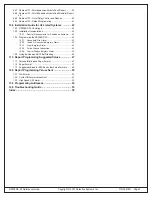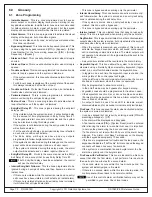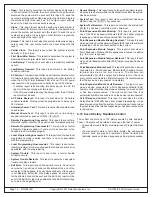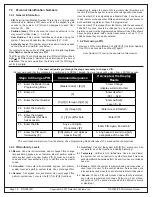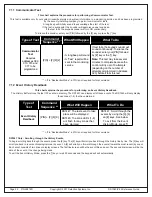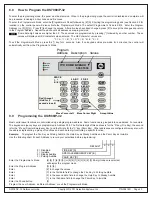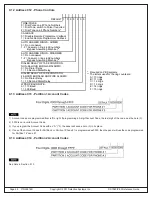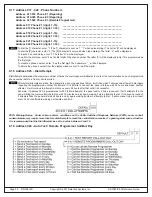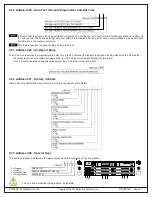
Page 16 P/N 39818D Copyright © 2001 Detection Systems, Inc. DS7080iP-32 Reference Guide
7.0
Operating Guide
7.1
Fire Safety
This fire alarm system can provide early warning of a developing
fire. Such a system, however, does not ensure protection against
property damage or loss of life resulting from a fire. Any fire alarm
system may fail to warn for any number of reasons (e.g. smoke not
reaching a detector that is behind a closed door).
When considering detectors for residential applications, refer to
NFPA Standard 72, "The National Fire Alarm Code.” This standard
is available at a nominal cost from: The National Fire Protection
Association, Batterymarch Park, Quincy, MA 02269.
7.1.1 If Installed in Family Residences
Adherence to the NFPA Standard 72 can lead to reasonable fire
safety when the following items are practiced:
• Minimize hazards: Avoid the three traditional fire killers: smoking
in bed, leaving children home alone, and cleaning with flammable
liquids.
• Provide a fire warning system: Most fire deaths occur in the
home, the majority, during sleeping hours. The minimum level of
protection requires smoke detectors to be installed outside of each
separate sleeping area and on each additional story of the
dwelling.
For added early warning protection, it is recommended that detectors
be installed in all separated areas including the basement, bedrooms,
dining room, utility room, furnace room, and hallways.
7.1.2 Having and Practicing an Escape Plan
A fire warning may be wasted unless the family has planned in
advance for a rapid and safe exit from the building.
• Draw a floor plan of the entire house showing two exits from each
bedroom and two from the house. Since stairwells and hallways
may be blocked during a fire, the plan should provide exits from
bedroom windows.
Make copies of the plan and practice it with all family members.
• Pre-arrange a meeting place outside and away from the residence.
Once out of the building, all occupants should immediately go to
the pre-selected location to be accounted for.
• Provide a barricade between family members and fire, smoke,
and toxic gases (e.g. close all bedroom doors before retiring).
• Children should be instructed on opening their bedroom windows
and exiting safely from the building. If exiting is not possible, they
should be taught to stay at the open window and shout for help
until it arrives.
• In the event of a fire alarm after retiring, wake the children by
shouting to them from behind your closed door. Tell them to keep
their bedroom doors closed.
• If the top of your bedroom door is uncomfortably hot, do not open
it. There is most likely fire, intolerable heat, or smoke on the other
side. Shout to all family members to keep their bedroom doors
closed and to exit the building via alternate routes.
• If the top of the door is not uncomfortably hot, brace the bottom of
the door with your foot, and the top with one hand, then open the
door about one inch. Be prepared to slam the door shut if there is
any pressure against the door or if any hot air rushes in.
• If there is no evidence of excessive heat or pressure, leave the
room and close the door behind you. Shout appropriate
instructions to all family members and immediately leave the
building via the pre-planned routes. If heavy smoke is present,
drop to your hands and knees and crawl to remain below the
smoke level.
7.1.3 Installation Considerations
Proper location of detection devices is one of the most critical factors
in a fire alarm system.
The following are some general considerations:
• Smoke detectors should not be installed in "dead air" spaces or
close to ventilating or air conditioning outlets because smoke may
be circulated away from the detector. Locations near air inlets
should be favored.
• Avoid areas subject to normal smoke concentrations such as
kitchens, garages, or near fireplaces.
• Do not install smoke detectors where normal area temperatures
are above 100 degrees F (38 degrees C) or below 32 degrees F
(0 degrees C).
• Areas of high humidity and dust concentrations should be avoided.
• The edge of ceiling mounted detectors should be no closer than
4 inches (10 cm) from any wall.
• Place the top edge of wall mounted detectors between 4 and 12
inches (10 to 30 cm) from the ceiling.


